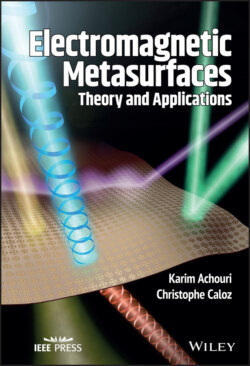Читать книгу Electromagnetic Metasurfaces - Christophe Caloz - Страница 15
2.2.1 Causality and Kramers–Kronig Relations
ОглавлениеWe have mentioned that matter is temporally dispersive and shown that the corresponding medium parameters at a given instant of time depend on the excitation at previous times. Combining these facts with the concept of causality allows one to relate the real and imaginary parts of the material parameters to each other. The corresponding relations are referred to as the Kramers–Kronig relations. Given their crucial importance and given their unclear presentation in the literature, we shall now precisely derive them.
The fundamental tenet of causality is that an effect cannot precede its cause, so that, in particular, matter cannot respond before being excited. Therefore, assuming that a medium starts to be excited at , its response at must necessarily be zero. We have thus [59]
(2.7)
where represents the variation of any of the susceptibility components in (2.3) from the steady-state regime, is the Heaviside step function, and is an arbitrary function that satisfies for . Transforming (2.7) to the frequency domain, we get
(2.8)
where
(2.9)
with representing the Fourier transformation operation, being the Dirac delta distribution, and PV denoting the principal value of its argument. Substituting (2.9) into (2.8) leads to the explicit convolution relation
(2.10)
Noting that is a complex quantity, we can rewrite (2.10) in the more explicit form
(2.11)
where and are the real and imaginary parts of , respectively. Since may take arbitrary values for , we chose such that it is time-symmetric (or even), i.e. , which leads to a purely real function . We can then separate (2.11) into its real and imaginary parts as
(2.12a)
(2.12b)
Substituting (2.12a) into (2.12b) yields
(2.13)
Following a similar procedure with a time-asymmetric function, i.e. , corresponding to a purely imaginary , we obtain
(2.14)
Equations (2.13) and (2.14) are the sought Kramers–Kronig relations. They indicate that variations in the real part of the medium parameters are necessarily associated with specific variations in their imaginary parts. For a quantity such as the refractive index, for instance, this implies that transforming an electromagnetic wave (e.g. negatively refracting it) from the real part of the index (e.g. making it negative) necessarily results in a variation of the imaginary part of the index, which corresponds to inserting loss, and vice versa.
